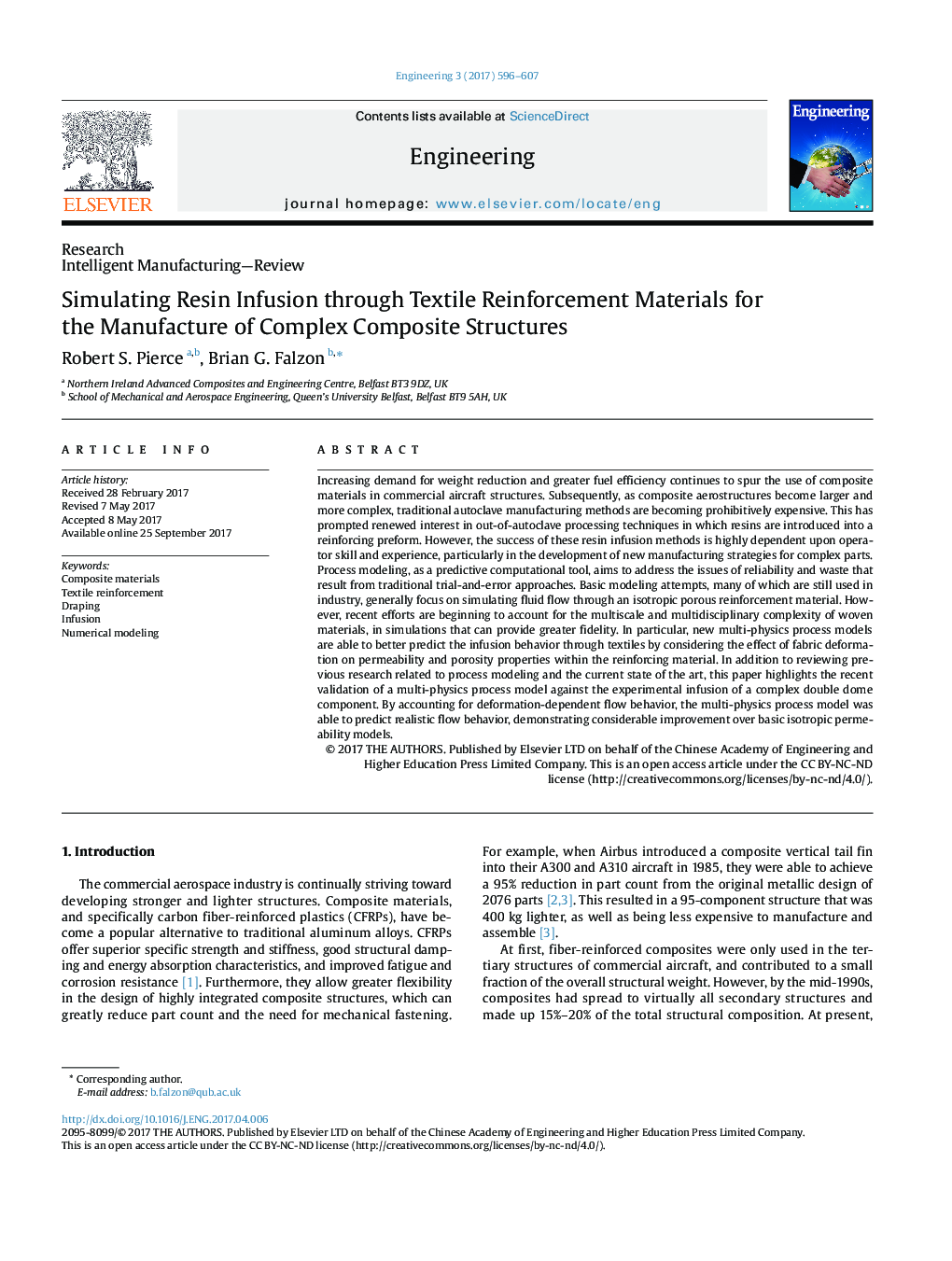| کد مقاله | کد نشریه | سال انتشار | مقاله انگلیسی | نسخه تمام متن |
|---|---|---|---|---|
| 6893432 | 1445562 | 2017 | 12 صفحه PDF | دانلود رایگان |
عنوان انگلیسی مقاله ISI
Simulating Resin Infusion through Textile Reinforcement Materials for the Manufacture of Complex Composite Structures
ترجمه فارسی عنوان
شبیه سازی تزریق رزین از طریق مواد تقویت نساجی برای ساخت سازه های کامپوزیتی پیچیده
دانلود مقاله + سفارش ترجمه
دانلود مقاله ISI انگلیسی
رایگان برای ایرانیان
کلمات کلیدی
ترجمه چکیده
افزایش تقاضا برای کاهش وزن و بازده بیشتر سوخت، به استفاده از مواد کامپوزیتی در سازه های تجاری تجاری کمک می کند. بعدها، به دلیل اینکه ساختارهای کامپوزیتی بزرگتر و پیچیده تر می شوند، روش های تولید اتوکلاو سنتی در حال تبدیل شدن به هزینه های بسیار گران قیمت هستند. این امر موجب علاقه جدیدی به تکنیک های پردازش خارج از اتوکلاو شده است که در آن رزین ها به یک قالب اولیه تقویت می شوند. با این حال، موفقیت این روش های تزریق رزین بسیار وابسته به مهارت و تجربه اپراتور، به ویژه در توسعه استراتژی های تولید جدید برای قطعات پیچیده است. مدل سازی فرآیند، به عنوان یک ابزار محاسباتی پیش بینی شده، هدف این است که مسائل مربوط به قابلیت اطمینان و ضایعات را که از روش های سنتی آزمون و خطا استفاده می کنند، مورد توجه قرار دهند. تلاش های مدل سازی پایه، که بسیاری از آنها هنوز در صنعت استفاده می شوند، عموما بر روی شبیه سازی جریان مایع از طریق یک ماده تقویت کننده متخلخل ایزوتروپیک تمرکز می کنند. با این حال، تلاش های اخیر برای مقابله با پیچیدگی های چند و چند رشته ای مواد بافته شده، در شبیه سازی هایی که می تواند وفاداری بیشتری را ارائه دهد، شروع می شود. به ویژه، مدل های فرایند چند فیزیکی جدید، قادر به پیش بینی بهتر رفتار تزریق از پارچه ها با توجه به تاثیر تغییر شکل پارچه بر نفوذ پذیری و خصوصیات تخلخل در مواد تقویت کننده می باشند. علاوه بر مرور تحقیقات قبلی مربوط به مدل سازی فرآیند و وضعیت فعلی هنر، این مقاله اعتبار جدیدی از یک مدل فرایند چند فیزیکی را در برابر تزریق تجربی یک جزء گنبد پیچیده دوگانه نشان می دهد. با توجه به رفتار جریان وابسته به تغییر شکل، مدل فرایند چند فیزیک قادر به پیش بینی رفتار واقعی جریان بود که نشان دهنده بهبود قابل توجهی نسبت به مدل های نفوذپذیری ایزوتروپ پایه است.
موضوعات مرتبط
مهندسی و علوم پایه
مهندسی کامپیوتر
علوم کامپیوتر (عمومی)
چکیده انگلیسی
Increasing demand for weight reduction and greater fuel efficiency continues to spur the use of composite materials in commercial aircraft structures. Subsequently, as composite aerostructures become larger and more complex, traditional autoclave manufacturing methods are becoming prohibitively expensive. This has prompted renewed interest in out-of-autoclave processing techniques in which resins are introduced into a reinforcing preform. However, the success of these resin infusion methods is highly dependent upon operator skill and experience, particularly in the development of new manufacturing strategies for complex parts. Process modeling, as a predictive computational tool, aims to address the issues of reliability and waste that result from traditional trial-and-error approaches. Basic modeling attempts, many of which are still used in industry, generally focus on simulating fluid flow through an isotropic porous reinforcement material. However, recent efforts are beginning to account for the multiscale and multidisciplinary complexity of woven materials, in simulations that can provide greater fidelity. In particular, new multi-physics process models are able to better predict the infusion behavior through textiles by considering the effect of fabric deformation on permeability and porosity properties within the reinforcing material. In addition to reviewing previous research related to process modeling and the current state of the art, this paper highlights the recent validation of a multi-physics process model against the experimental infusion of a complex double dome component. By accounting for deformation-dependent flow behavior, the multi-physics process model was able to predict realistic flow behavior, demonstrating considerable improvement over basic isotropic permeability models.
ناشر
Database: Elsevier - ScienceDirect (ساینس دایرکت)
Journal: Engineering - Volume 3, Issue 5, October 2017, Pages 596-607
Journal: Engineering - Volume 3, Issue 5, October 2017, Pages 596-607
نویسندگان
Robert S. Pierce, Brian G. Falzon,
